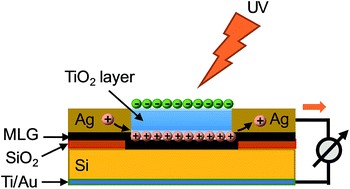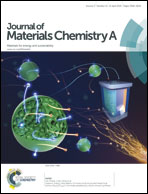TiO2 enhanced ultraviolet detection based on a graphene/Si Schottky diode†
Abstract
Graphene/Si has been proved to form a quality Schottky junction with high photoelectric conversion efficiency at AM 1.5. However, for the ultraviolet portion of the incident light, the photoelectric performance will degrade significantly due to severe absorption and recombination at the front surface. Herein, to realize enhanced ultraviolet detection with a graphene/Si diode, TiO2 nanoparticles (NPs, 3–5 nm) are synthesized and spin-coated on the graphene surface to improve the photoresponse in the ultraviolet region. According to our results, the conversion efficiency of the graphene/Si diode at 420 nm and 350 nm increases by 72.7% and 100% respectively with TiO2 coating. Then C−2–V measurements of both TiO2 and graphene/Si diode are performed to analyze the electronic band structure of the TiO2/graphene/Si system, based on which we finally present the enhancement mechanism of photodetection using TiO2 NPs.


 Please wait while we load your content...
Please wait while we load your content...